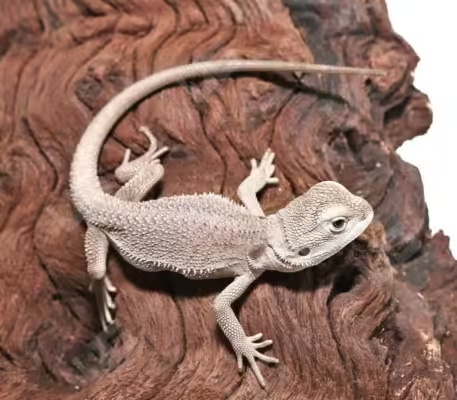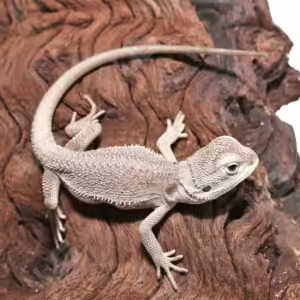Zero Bearded Dragon For Sale
$299.99
WE HAVE A ZERO BEARDED DRAGON FOR SALE. HERE ARE SOME HIGHLIGHTS:
- Pogona vitticeps
- Captive Bred
- Approximately 4-5 Inches In Length From Head To Tail
- Adults Can Grow Up To 18 – 24 Inches
- Feeding On Crickets, Mealworms And Dark Leafy Greens
FUN FACTS!
- Very Gentle Lizards, Easy To Handle, Great For Kids Or Beginners
- Desert Dwellers That Require A Hot Basking Area And UVB Lighting
- Originating Out Of Australia Mainly In The Hot Scrub And Arid Plains
- With Proper Care These Reptiles Can Live 7 – 10 Years In Captivity
Zero Bearded Dragons
Zero bearded dragons are a captivating morph within the bearded dragon species, renowned for their distinctive appearance and unique genetic makeup. Originating from the common bearded dragon, Pogona vitticeps, zero bearded dragons have gained significant attention in the reptile community due to their striking, patternless look and often light, monochromatic coloration.
The zero morph is a result of a specific genetic mutation that affects the pigmentation and pattern development in these reptiles. Unlike other bearded dragon morphs, which showcase a variety of patterns and colors, zero bearded dragons are characterized by their uniform, pale appearance. This morphological trait is what sets them apart, making them particularly appealing to both novice and experienced reptile enthusiasts.
Understanding the genetics behind the zero morph is crucial for breeders and hobbyists alike. The mutation responsible for the zero appearance is recessive, meaning that both parent dragons must carry the gene for their offspring to exhibit the zero traits. This genetic detail adds an element of intrigue and challenge to breeding zero bearded dragons, further contributing to their allure and popularity.
In recent years, the fascination with zero bearded dragons has surged, driven by their unique aesthetics and the growing community of reptile aficionados. Their serene, almost ethereal look makes them a standout in any collection, and their care requirements are similar to those of standard bearded dragons, making them accessible to a wide range of keepers.
As the interest in zero bearded dragons continues to grow, so does the body of knowledge surrounding their care, breeding, and genetic intricacies. This comprehensive guide aims to provide a detailed exploration of these remarkable reptiles, offering insights and practical advice for anyone interested in adding a zero bearded dragon to their collection or simply learning more about this fascinating morph.
Physical Characteristics
Zero bearded dragons are renowned for their distinct physical traits, which set them apart from standard bearded dragons. Notably, their coloration is one of the most distinguishing features. Unlike the typical bearded dragon, which displays a range of colors from browns and greens to oranges and reds, zero bearded dragons exhibit a monochromatic appearance. They are predominantly white or pale grey, lacking the vibrant hues seen in their counterparts. This unique coloration is due to the absence of specific pigments, making them highly sought after by reptile enthusiasts.
In terms of size, zero bearded dragons generally mirror the dimensions of standard bearded dragons. They typically grow to a length of 16 to 24 inches, with males often being slightly larger than females. Their weight can range from 300 to 500 grams, depending on their diet and overall health. Despite their similar size, the zero morph’s coloration can make them appear more delicate and elegant.
Another distinguishing feature of zero bearded dragons is their scale texture. While standard bearded dragons have a rough, spiked texture that provides a rugged appearance, zero bearded dragons tend to have smoother scales. This smoother texture contributes to their sleek, almost polished look. Additionally, their eyes are usually a striking feature; they can range from dark to light shades, often contrasting vividly with their pale skin.
Within the zero morph, slight variations in physical characteristics can occur. Some zero bearded dragons may have subtle patterns or markings, although these are generally faint compared to the bold patterns of standard bearded dragons. Such variations add to the uniqueness of each individual dragon within this morph.
Overall, the physical characteristics of zero bearded dragons make them a fascinating subject for reptile enthusiasts. Their unique coloration, size, and scale texture distinguish them from standard bearded dragons, offering a strikingly different aesthetic that captivates many admirers.
Behavior and Temperament
Zero bearded dragons, like other bearded dragons, are renowned for their generally docile and friendly nature. They are considered to be among the more gentle and approachable reptiles, making them popular choices for pet owners. Compared to other bearded dragon morphs, zero bearded dragons do not exhibit a significant increase in aggression. Instead, they often display a calm demeanor, which makes them suitable for handling and interaction with humans.
Interaction with humans is generally positive; zero bearded dragons can develop a bond with their owners over time. They are known to recognize their caregivers and can become accustomed to regular handling. This bond can result in a more trusting and relaxed dragon, which is beneficial for both the pet and the owner. Consistent, gentle handling from a young age can further enhance their docile temperament.
When it comes to other pets, zero bearded dragons can coexist harmoniously, provided that introductions are managed carefully. They should never be left unsupervised with other animals, as stress or defensive reactions can occur. Nonetheless, with proper acclimatization, some owners have successfully integrated their zero bearded dragons into homes with other reptiles or even small mammals.
The activity levels of zero bearded dragons are moderate. During the day, they are typically active, engaging in behaviors such as basking, exploring their enclosure, and hunting for food. They are diurnal creatures, meaning they are awake during the day and sleep at night. Offering a variety of enrichment activities, such as climbing structures and interactive feeding, can help keep them stimulated and healthy.
Unique personality traits in zero bearded dragons may include a heightened tolerance for handling and a curious nature. Each individual dragon will have its own quirks and preferences, so it is important for owners to spend time observing and interacting with their pet to understand its specific needs and characteristics. By doing so, owners can ensure a fulfilling and enjoyable relationship with their zero bearded dragon.
Housing and Habitat Requirements
Creating the optimal habitat for zero bearded dragons is essential for their health and well-being. The enclosure should be spacious enough to allow for their natural behaviors. A 40-gallon tank is the minimum recommended size for a single adult dragon, though larger enclosures, such as 75-gallon tanks, are preferable to provide ample space for movement and enrichment.
The enclosure should be constructed of glass or acrylic, with a secure, well-ventilated top to maintain a controlled environment. Temperature regulation is crucial; the habitat must have a thermal gradient to allow the dragon to thermoregulate. The basking area should reach temperatures between 95-110°F (35-43°C), while the cooler end should range from 75-85°F (24-29°C). Nighttime temperatures can safely drop to 65-75°F (18-24°C).
Humidity levels should be maintained between 30-40%. This can be achieved by ensuring proper ventilation and avoiding excessive misting. A hygrometer can be used to monitor humidity levels accurately.
Lighting is another critical aspect. Bearded dragons require UVB lighting to synthesize vitamin D3, which is vital for calcium absorption. A UVB bulb should be placed within 12-18 inches of the basking spot and replaced every six months to ensure effectiveness. In addition to UVB, a heat lamp should be used to create a basking area, simulating the natural sun exposure they would receive in the wild.
Choosing the right substrate is important for the safety and comfort of zero bearded dragons. Reptile carpet, paper towels, or non-adhesive shelf liner are recommended to prevent impaction, a common issue with loose substrates like sand or wood chips. These materials are easy to clean and replace, ensuring a hygienic environment.
Enriching the habitat with decorations and hiding spots can significantly improve the dragon’s quality of life. Rocks, branches, and logs provide opportunities for climbing and basking, while artificial plants and hides offer security and stimulation. Ensuring a variety of textures and elevations within the enclosure can mimic the dragon’s natural environment, promoting physical and mental well-being.
Diet and Nutrition
Zero bearded dragons, much like their counterparts, require a diet that is carefully balanced to ensure their health and longevity. Their diet is omnivorous, encompassing a variety of insects and vegetables. Juvenile zero bearded dragons have a higher protein requirement, thus their diet should consist of approximately 80% insects with the remaining 20% being vegetables. Conversely, adults should have a diet where vegetables make up about 80% and insects 20%.
A list of safe and nutritious food options for zero bearded dragons includes crickets, mealworms, and dubia roaches as primary insect choices. Vegetables such as collard greens, mustard greens, and squash are beneficial. Fruits like strawberries and blueberries can be offered sparingly as treats. It is essential to avoid feeding them spinach and kale, as these can bind calcium and hinder absorption.
Establishing a regular feeding schedule is crucial. Juveniles typically require feeding twice a day, whereas adults can be fed once daily or every other day. It is advisable to feed insects that are appropriately sized—no larger than the space between the dragon’s eyes—to prevent choking. Additionally, insects should be gut-loaded with nutritious foods before being offered to ensure they provide optimal nutrition.
Supplements play a vital role in maintaining the health of zero bearded dragons. Calcium powder, ideally with Vitamin D3, should be dusted on their food about three times a week for juveniles and twice a week for adults. A multivitamin supplement can also be offered once a week.
Proper hydration is equally important. While zero bearded dragons derive some moisture from their food, providing a shallow water dish is essential. Mist the enclosure and offer water droplets directly on their snouts to encourage drinking. Hydration helps in maintaining skin elasticity and overall health.
In summary, understanding the dietary needs of zero bearded dragons and providing a balanced diet with appropriate supplements and hydration is key to their well-being. Tailoring their diet according to their life stage ensures they thrive and remain healthy.
Health and Common Issues
Zero bearded dragons, like other reptiles, are susceptible to a variety of health issues. One prevalent condition is metabolic bone disease (MBD), which results from a lack of calcium or vitamin D3. Symptoms include lethargy, swollen limbs, and a softening jawbone. Preventative measures include providing a UVB light source and ensuring a diet rich in calcium. Regularly dusting their food with calcium powder can also help maintain healthy bone structure.
Respiratory infections are another common ailment, often caused by inadequate humidity levels or poor ventilation. Symptoms to watch for include wheezing, nasal discharge, and lethargy. To prevent respiratory infections, maintain appropriate humidity levels and ensure the enclosure is well-ventilated. If symptoms persist, consult a veterinarian experienced with reptiles for diagnosis and treatment.
Parasites, both internal and external, can also affect zero bearded dragons. Internal parasites, such as worms, can cause weight loss and a lack of appetite, while external parasites like mites may lead to excessive scratching and skin irritation. Routine fecal exams and regular tank cleanings are essential preventive measures. If parasites are detected, a vet can prescribe the appropriate medication.
Regular veterinary care and routine health checks are crucial for maintaining the overall well-being of zero bearded dragons. Annual check-ups can help identify and address potential health issues before they become problematic. Additionally, maintaining a clean environment, providing a balanced diet, and ensuring proper lighting and temperature conditions are pivotal in promoting their health.
By staying vigilant and proactive, owners can significantly reduce the risk of common health issues. Recognizing symptoms early and taking preventative measures can ensure that zero bearded dragons lead healthy, thriving lives.
Breeding Zero Bearded Dragons
Breeding zero bearded dragons requires careful planning and meticulous attention to detail. The selection of breeding pairs is paramount; both dragons should exhibit desirable traits and be free from any genetic defects. It’s crucial to ensure genetic diversity to prevent inbreeding, which can lead to potential health complications. Thus, sourcing dragons from different bloodlines is recommended.
Preparing for breeding involves creating an optimal environment conducive to mating. This includes ensuring appropriate lighting, temperature, and diet to stimulate breeding behaviors. The enclosure should mimic their natural habitat, with adequate basking spots and hiding places to reduce stress. Additionally, supplementing their diet with calcium and vitamins is essential for the health of the gravid female and the development of the eggs.
Once the female is gravid, or pregnant, special care must be taken. She will require a nesting area filled with a substrate like moist vermiculite or sand, where she can lay her eggs. It’s important to monitor her closely, ensuring she remains hydrated and well-fed, as gravid females can be more susceptible to stress and health issues.
After the eggs are laid, they should be carefully transferred to an incubator set to a temperature around 82-86°F (28-30°C) with a humidity level of approximately 75%. The incubation period typically lasts between 40 to 60 days. During this time, maintaining consistent temperature and humidity levels is crucial for the successful development of the embryos.
Hatching is an exciting phase that requires patience. Once the young dragons emerge, they should be housed separately to prevent competition and aggression. Their diet should consist of appropriately sized insects and finely chopped vegetables to support their rapid growth. Regular monitoring for any signs of health issues is essential, as young dragons are more vulnerable than their adult counterparts.
Understanding the genetic considerations is vital throughout the breeding process. Breeders must be aware of the potential for genetic disorders and strive to maintain a healthy gene pool. By adhering to these guidelines, breeders can ensure the successful propagation of zero bearded dragons, contributing to the diversity and health of the species.
Frequently Asked Questions
Zero bearded dragons are a unique and fascinating morph. Here, we address some of the most frequently asked questions about their care, behavior, lifespan, and specific challenges.
What is a Zero Bearded Dragon?
A Zero bearded dragon is a morph known for its lack of color and pattern. They are typically white or grey, which makes them stand out from other bearded dragon morphs. This distinct appearance is due to a genetic mutation that affects pigmentation.
How Do I Care for a Zero Bearded Dragon?
Zero bearded dragons require similar care to other bearded dragons. This includes a well-maintained habitat with proper lighting, heating, and humidity. A diet consisting of insects and vegetables is necessary to ensure they receive the appropriate nutrients. Regular vet check-ups are also recommended to monitor their health.
What is the Lifespan of a Zero Bearded Dragon?
The lifespan of a Zero bearded dragon is typically between 10 to 15 years, given proper care. Factors such as diet, habitat conditions, and overall health can influence their longevity. Routine veterinary care and a balanced diet are crucial for a long, healthy life.
Are Zero Bearded Dragons Friendly?
Zero bearded dragons are known for their docile and friendly nature. They can be easily handled and often enjoy human interaction. However, temperament can vary among individuals, so it’s essential to spend time bonding with your pet.
What Are Some Specific Challenges with Zero Bearded Dragons?
One of the primary challenges is their sensitivity to light due to their lack of pigmentation. This means they may require more careful management of UVB lighting to prevent issues such as photo-sensitivity. Additionally, like other bearded dragons, they are susceptible to common health issues like metabolic bone disease and respiratory infections.
Overall, Zero bearded dragons make unique and fascinating pets with their distinct appearance and friendly demeanor. Proper care and attention to their specific needs will ensure they thrive in captivity.

Be the first to review “Zero Bearded Dragon For Sale” Cancel reply
Related products
Bearded Dragons


















Reviews
There are no reviews yet.